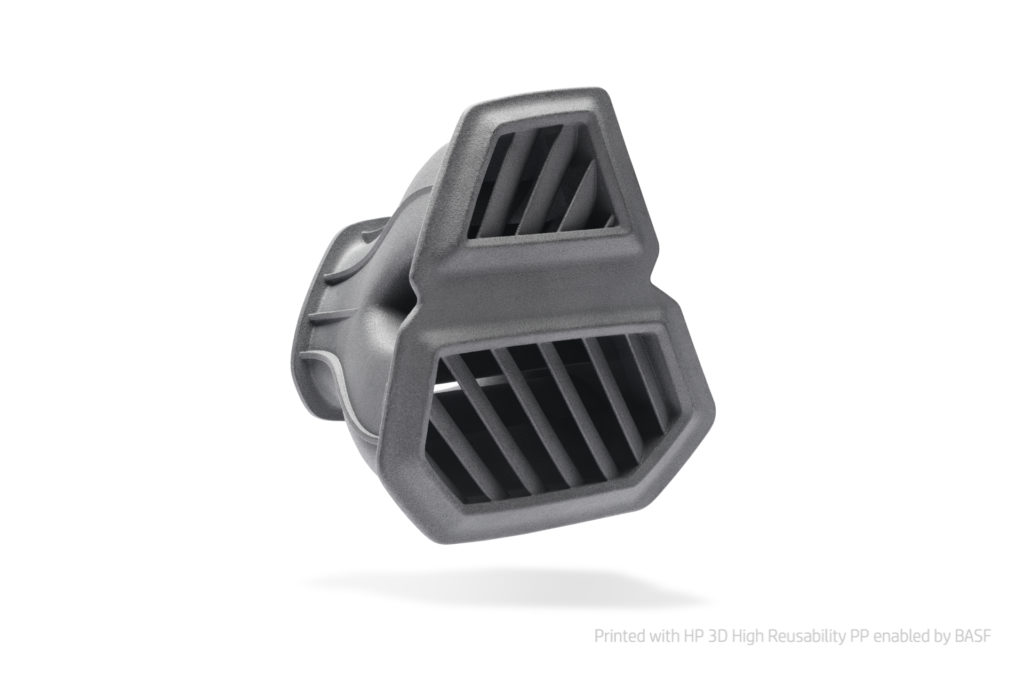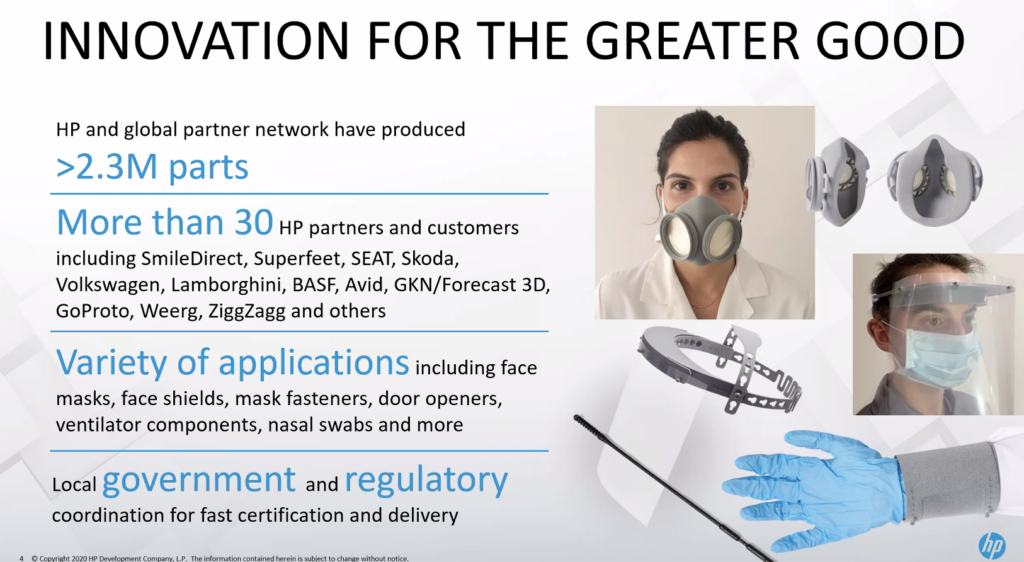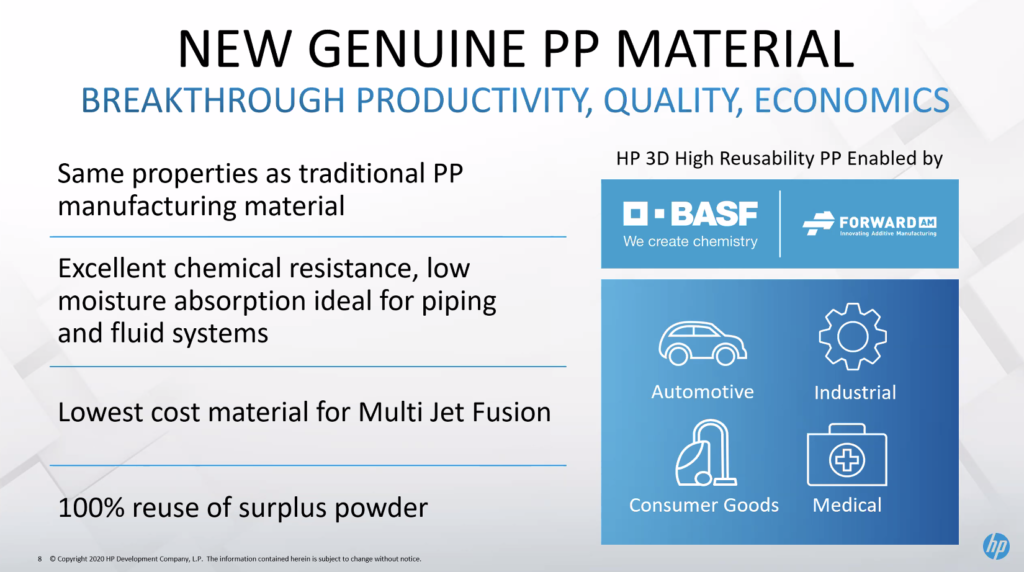HP’s interim head of 3D Printing, Ramon Pastor, announced in a press conference that the company was “doubling down on driving adoption for 3D printing.” He called the COVID crisis a “watershed moment for the industry.” HP and its partners made over 50 million MJF parts total to date and have made 3.2 million COVID parts, including 500,000 face shields for Canada during the crisis. HP also announced today that it has released polypropylene (PP) for its MJF systems, will offer training and an assessment tool to accelerate adoption, and has partnered with Oechsler.

Car door defroster vent, made in MJF PP (Image credit HP)
The firm sees its North Star in “helping customers to move to a much more on-demand, customized approach” in the digitization of manufacturing. COVID, therefore, “totally disrupted the supply chain” and “we’ve seen the limits of centralized supply chains…of supply chains optimized for cost.” With 3D printing, HP partners were “repurposing whole factories,” showing “the power of flexible manufacturing” in days, while HP itself “used its knowledge of additive manufacturing to help design qualify and manufacture parts” quickly. Indeed, nasal swabs went from idea to FDA approval to production in less than two weeks. This crisis also showed that “duplication [of a factory] in two different countries” is not resilience and, instead, you have to be as “flexible and agile as possible” with “a distributed set up.”

In addition to a COVID update, the firm also told us of the availability of a parts assessment tool that will help customers find out if their components make good candidates for printing and help them estimate costs. This will make clearer if certain business cases in additive add up for customers. A better idea of cost is something that was sorely lacking for many companies and designers new to additive. The company will also be offering design-for-additive training programs, which should help engineers and designers adopt 3D printing more widely and quickly. Additionally, the company will be helping with design optimization and application development support. HP has now added FastRadius to its partner network, which encompasses GKN, Materialise, Jabil and others.

The firm will roll out a multi-year partnership with Cobra to make customized golf clubs and do a virtual inventory project with the U.S. Marine Corps for 300 spare parts for vehicles. Especially overseas, military spare parts is a huge potential market with modern militaries having up to six people support one frontline soldier. Immense logistical challenges could be overcome by 3D printing some spares in-country or at the field of battle. Golf clubs and customized sports equipment, especially handles, to me are an unexplored frontier in consumer goods and could very well give us all much better (and more expensive!) sports equipment that would be more comfortable and perhaps improve our play.

The most exciting announcement was the release of polyproylene (PP), which is now the least expensive material in HP’s portfolio. PP is a bulk polymer that is very versatile and one of the widest and most popular polymers on the market. PP is a tough, soft, and flexible commodity polymer that has excellent chemical resistance, good fatigue resistance and none of the associated moisture issues that plague many 3D printing materials, such as PA and PLA. With good wear and weather resistance, it is also easily sterilized, has good barrier properties, and has a wide net of application areas.
PP is used in furniture, luggage, cases, toys, outdoor furniture, bottle lids, interior automotive components in the cabin, exterior components such as bumpers, and a variety of medical products. This includes medical disposables and items such as pill bottles, Petri dishes, syringes, trays and medical packaging. With a 165°C melting temperature and a continuous service temperature of around 120°C, PP is used very widely in many non-medical packaging applications, including containers and housings.

As a prototyping material, I’m very excited at the release of PP for HP. For a lot of companies in furniture, medical goods, drinks packaging, and in automotive, PP is an essential material to be able to replicate or have when prototyping. It has traditionally been difficult for us to make 3D printing materials with the same fatigue resistance and degree of toughness and flexibility that PP has.

Air duct in HP High Reusability PP by Oechsler
Prototyping drinks lids and flexible, but rigid, containers has been a nightmare because nothing had quite the same properties. There were whole sectors such as medical disposables or packaging that were never really able to prototype well using 3D printing for much of their portfolios and now can. For functional prototypes, such as car interior parts like cup holders and trays, this material is also a godsend. Sometimes assemblies and parts for toys and consumer electronics would break during testing because the materials used couldn’t flex and resist tearing like PP does. This could also potentially be solved now.

Degas bottle by Extol.
I’m also delighted at the thought of PP as a manufacturing material for MJF. Low cost and high recyclability could make this an extremely cost-effective material and enable many more 3D printing applications. Typically sintering you may throw away around half of your powder annually (this depends on nesting, packing, the material etc.). If the reuse rate of this material is significantly higher then this could really affect the overall economics of part costs for the industry.
Medical is a hot topic now, but I do think that low production run medical disposables are a nice market that one could now manufacture for. I really like custom packaging: 3D-printed trays so that surgical instrumentation can all be laid out precisely in the right order for a particular procedure is an idea that should become more prevalent. I also like PP as the default packaging material for all of our mass-customized goods. If you get mass-customized, 3D-printed headphones or a hearing aid, then we’ll print you an individualized case that fits it precisely. If mass customization is to become a reality, then it should need mass-customized packaging as well, partially to complete the experience, but also because, if your item isn’t one-size-fits all, your packaging can’t be either. I also really enjoy how PP for MJF enables new business ideas, such as better custom cases for phones; low-volume packaging businesses for Etsy sellers; cases for the ‘long tail’, tough customized handles for bikes or sports equipment; custom safety gear and more. My mind is currently racing at all the possibilities.

Additionally, HP announced today that it has expanded partnerships with both BASF and Oechsler. BASF is the chemical giant that is one of the suppliers for HP’s TPU and now its PP supplier. There is a risk now with the deepening of the BASF partnership that some of HP’s material partners for its ecosystem could be more equal than others. HP has assembled a lot of key polymer companies to take part in its ecosystem and needs to maintain balance for them all to keep supporting it.
The Oechsler partnership is a key one to tackling the future of 3D printing. Oechsler is an applied plastics company that takes polymers and develops them into fully-fledged application-ready products, mainly for the automotive industry. The company makes an awful lot of parking brakes as an integrated complex component and also produces sports shoes and medical and safety equipment. It’s a 150-year-old dream partner to take a lot of particular 3D printing ideas and produce them at scale. The company has invested in 3D printing by opening its own facilities for production, and was the Adidas & Carbon partner for the 3D-printed midsole (it is also the main manufacturer of Adidas’ Boost line of shoes). This partnership is quite the coup for HP. Firms like Oechsler are crucial for scaling up and manufacturing with 3D printing.
All in all, I think we’re all happy to see HP making so much progress and creating so much inertia for itself. The company seems firmly focused on tackling the important things holding back 3D printing and on creating a 3D-printed future for itself and by extension the rest of us. This kind of progress forces everyone else to work harder and will be good for the entire industry.
Subscribe to Our Email Newsletter
Stay up-to-date on all the latest news from the 3D printing industry and receive information and offers from third party vendors.
You May Also Like
Air Force Awards Fortius Metals $1.25M to Qualify 3D Printing Wire for Hypersonic Applications
AFWERX, part of the US Air Force Research Laboratory (AFRL), awarded a Direct-to-Phase II Small Business Innovation Research (SBIR) contract worth $1.25 million to Colorado’s Fortius Metals, to accelerate qualification...
US Air Force Awards JuggerBot $4M for Large-format Hybrid 3D Printing
Large-format 3D printer manufacturer JuggerBot has received a $4 million grant to develop a large format 3D printer, courtesy of the Under Secretary of Defense, Research and Engineering Manufacturing Technology...
Where Have All AM’s Unicorns Gone?
In the rapidly evolving world of 3D printing, startups valued at over a billion dollars, known as unicorns, once seemed as fantastical as the mythical creatures themselves. While a few...
How My Childhood Fascination with Planes Led to Investing in 3D Printing
My fascination with aerospace started young, and I started studying planes–identifying them in the sky and learning everything I could about how they work. Fast forward to my first week...































